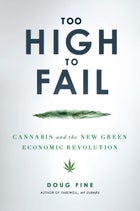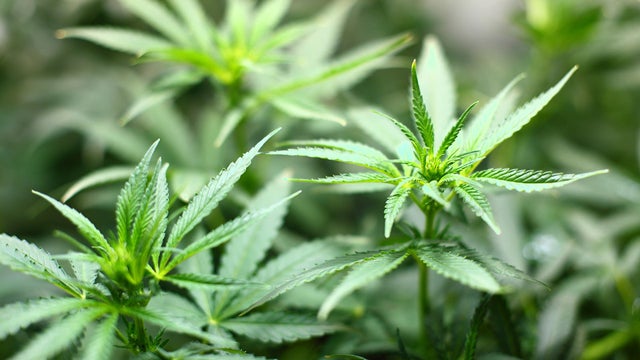Thomas Jefferson wrote the Declaration of Independence on cannabis-derived paper. Yet, two centuries later, cultivation and use of the plant is a federal offense that has turned us, as Doug Fine writes in (Gotham Books; $26), into “the most highly incarcerated society in history.” Imagine the absurdity of locking up farmers and diners everywhere for their dealings with the grape.

Fine finds further absurdity in the fact that in 2010, with an ailing economy in need of a trillion-dollar budget cut, federal spending on the American Drug War increased 3.3 percent to a record $15.5 billion. Forty years and a trillion dollars in, the war on drugs has been America’s longest and perhaps most ineffective (agents seized only one percent of estimated contraband in 2010 at a cost of $300 to each U.S. taxpayer).
Too High to Fail������ ’s well-researched journey into the world of legal cannabis farming and a funny, maddening account of those farmers’ travails under federal persecution on an island of legality—the paradisiacal Mendocino County, California. Fine’s investigation is rooted in an economic conundrum: America’s number-one cash crop is costing it money (and profiting violent Mexican cartels) rather than generating tax revenue in a time of crisis.
Wife and children in tow, Fine packs up and moves to Mendocino County for a year to see firsthand what a sustainable and legal cannabis industry looks like. What he finds is a thriving small-town community of typical farmers who want nothing more than to grow their prized crop and pay their taxes while providing essential medicine to thousands of ailing patients. And Fine fits in with the Mendo vibe, bearded and driving his vegetable-oil-fueled truck redolent of Kung Pao chicken.
Once settled in, Fine follows the efforts of Tomas Balogh, a young cannabis farmer who formerly grew indoors to pay his tuition at the University of California, Berkeley and now hopes to launch his non-profit Kama Collective to provide medical marijuana under Mendocino’s successful 9.31 Zip-Tie Program. Farmers participating in the program can grow up to 99 plants in exchange for a hefty $8,500 fee per farmer per year—revenue that pads the county’s budget and saved the jobs of seven deputies. (Cannabis generates $8.1 billion annually for Mendocino—85 percent of its local economy. “Anyone who crunches the numbers can see that simple decriminalization of cannabis can almost immediately act as … a significant piece of national economic recovery,” Fine writes.)
Balogh, an incorrigible optimist, overhauls “The Eagle’s Nest,” an idyllic plot of land where Fine observes a single plant, named Lucille, over the course of nine months from seed to patient. Along the way, Fine documents the miracles and setbacks that beleaguer Balogh’s budding collective, reeling all the while from the sweet effluvium of Lucille’s terpenes, his fingers permanently sticky with the mucilage of her buds.
Despite the challenges, Fine comes to see in Mendocino’s example—its proud and hardworking, taxpaying farmers who actively contribute to the health of their community—that an end to cannabis prohibition is inevitable. This is a place where local law enforcement team up with pot growers to ensure community safety against real crimes, like domestic violence … and cannabis theft. Matt Cohen, local “ganjapreneur” and poster child of the burgeoning legal cannabis industry, called the police when a gust of wind set off his cannabis field’s burglar alarm, and they treated him like the law-abiding citizen that he is.
But even in this apparent utopia, not all is well in the green revolution. Fine himself has a run-in with the authorities, who take him for a drug runner in his hippie truck. At harvest, feds raid Cohen’s farm and destroy his 9.31-permitted crop, and his legal collective’s drivers are arrested while trying to deliver medicine to registered patients, who are forced to buy from the cartel-controlled black market or resort to less effective prescription pills (pharmaceutical companies don’t support cannabis legalization, since its greater versatility, effectiveness, and safety would cut into profits.) It’s the mark of a civil war, the government against its citizens. “The Drug War is as unconscionably wrong for America as segregation and DDT,” Fine argues.
It’s in Fine’s constant reminders of federal Drug War idiocy, though, that even the most pro-ganja readers may grow weary. Fine does a superb job of germinating indignation on behalf of this superplant and its advocates, but the facts, numbers, and fed-bashing ultimately become redundant. Fine would do better to nix these repetitions and stick to the riveting narrative.
Ultimately, Fine’s tale is a hopeful one. Amid the federal crackdown, Balogh gathers his harvest and insists on delivering the first batch of Kama Collective medicine himself to a pair of Matt Cohen’s deprived elderly patients, who suffer from chronic pain and chemo-induced appetite loss. Fine and Balogh watch as Lucille is rolled into a joint and burned to a fragrant gas, like “steam from a cup of just-picked mint tea.” “A police car screamed past outside, pursuing crime,” Fine writes. “There was none here.”


